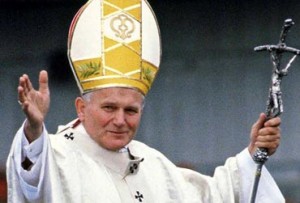“Santo Subito!”
The average wait to see him was 13 hours. The line was over 3 miles long. Over 150 cardinals concelebrated, 700 archbishops and bishops were present, and 3,000 priests participated.
It was the largest gathering of statesmen in human history. It was the first time an Ecumenical Patriarch of the Orthodox Church had attended a papal funeral since the Great Schism of 1054. 159 foreign delegations were in attendance, as were 10 kings, 5 queens, 3 princes, 59 heads of state, 17 prime ministers, 10 presidents, 8 vice presidents, 12 foreign ministers, 24 ambassadors, general directors, secretary generals or presidents of international organizations, 23 delegations of Orthodox and Eastern Orthodox Churches, 8 Churches or ecclesial communities, international Christian organizations, and Jewish delegations.
More than 3 million pilgrims came together in Rome for the funeral of Blessed John Paul II on April 8, 2005.* And the people cried “Santo subito!”
Loosely translated, it means “saint him now!” The process for beatification, however, could not, as it was written then, begin for at least another five years. Then add the further study of his writings and letters, a massive volume of work to be sure, and the wait for Heaven’s signature in the form of a supernatural sign or miracle through John Paul’s intercession.
Was this cry for canonization coming, as some believed, too fast? Was this pressure from the faithful crying out “santo subito” unwarranted?
It’s often recalled when someone is in the midst of a struggle or crisis that “pressure makes diamonds.” Tremendous heat and tremendous pressure, applied to carbon deep in the heart of the earth will create exquisite, nearly unbreakable gemstones.
God seems to have imprinted in so many physical realities and natural processes, lessons in matters of the human spirit; perfect parallels that can illuminate human life through a close examination of the biological. There are parables impregnated into the very fabric of the world if we allow ourselves to see them, and to hear them
When one looks at the multi-faceted life and unbreakable character of Karol Wojtyla, the future St. Pope John Paul II, it would seem the pressures that surrounded him must have been nearly beyond comprehension; an unequaled intensity forged his character as surely as the carbon is heated and crushed by the primordial weight of the world. These pressures have created for us, and for Heaven, a gem of astounding beauty.
The early suffering of losing his mother, brother, and father before the age of 21 might have been enough to crack a more fragile heart, but for young Karol it created early on a true sensitivity, and a tender affection for the Mother of God to whom he turned more deeply in prayer.
The demonic fire of the Nazi regime, which ensnared many of his peers and close friends, literally forced him into an underground theater to act and to perform the noble qualities of his Polish heritage. That pressure gave him a deep loyalty to his native soil, which later would expand into a powerful respect and connection with the soil of other lands.
He was known for kissing the ground as an act of respect and gratitude whenever he stepped off the airplane in his trips around the world. When the communist regime took over and applied pressure on his priesthood, it only served to create a body connected in deeper solidarity.
In one of the many powerful scenes of his 27 year papacy, tear gas was thrown to break up the masses gathered outdoors for Holy Mass. As the panic mounted, a monsignor beside him whispered that he should perhaps take his leave before things became more violent. With unbreakable resolve, he halted, and full voice cried out to the crowd and to the gathering darkness, “Love is stronger! Love…is…stronger!
To the end, this unbreakable quality in John Paul II would remain. He would, with a diamond’s brilliance, catch the light of the Son and illuminate the places he would travel, and he would travel until the end. Only death, it would seem, could break him.
And even there, he seemed not to yield, not to be crushed utterly but to rise again for another day. That final day, the one on which he would hand over his spirit and return to the Father’s House would be the Feast of Divine Mercy. Like his Lord and Savior, he would hold out until that final piercing, when the rock would be struck and blood and water flow out.
This April 27, 2014, is another Divine Mercy Sunday. It has only been nine years since his passing; a novena of years in which the Universal Church has been waiting, praying, hoping. And now we can all cry out anew, “Santo subito!”The day has come, and he wears the crown of everlasting splendor, and its light shines from the communion of saints on us all!
“You were in Eden, the garden of God; every precious stone was your covering, sardius, topaz, and diamond…On the day that you were created they were prepared…you were on the holy mountain of God; in the midst of the stones of fire you walked. You were blameless in your ways from the day you were created…”
– Ezekiel 28:13-14
________________________
* Statistics taken from CNA


